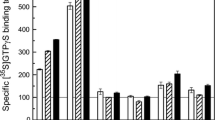Abstract.
In previous paper based on classical pharmacological tools, we identified a Gi protein-coupled presynaptic 5-hydroxytryptamine (5-HT) 1B receptor causing inhibition of dopamine (DA) release in rat striatal synaptosomes. It was the aim of the present study to further explore this receptor, using 5-HT moduline, a polyclonal antibody directed against 5-HT1B receptors and 5-HT1B receptor knock-out mice.
Preincubation of rat striatal synaptosomes with 5-HT moduline (0.1, 1, or 10 μM) significantly reduced the inhibitory effect of CP93,129, a selective rat 5-HT1B receptor agonist, on K+-evoked overflow of [3H]DA in a non-competitive manner: 5-HT moduline did not modify the IC50 of CP93,129, but concentration-dependently reduced the maximal inhibitory effect. Preincubation of rat striatal synaptosomes with a specific polyclonal 5-HT1B receptor antibody also resulted in a significant attenuation of the inhibitory effect of CP93,129 on K+-evoked overflow of [3H]DA. In female 129/Sv wild-type mice, CP93,129 and 5-carboxyamidotryptamine maleate (5-CT), a non-selective 5-HT1B receptor agonist, inhibited the K+-evoked [3H]DA overflow in a concentration-dependent manner. Sumatriptan, a selective rat 5-HT1D receptor agonist, did not modify the overflow of [3H]DA. SB224289, a selective 5-HT1B receptor antagonist, abolished the inhibitory effects of CP93,129 and 5-CT. The inhibitory effects of CP93,129 and 5-CT were absent in synaptosomes from 5-HT1B receptor knockout mice. No compensatory inhibition effect in mutant mice was observed using sumatriptan.
In conclusion, the results show that a non-competitive antagonist of the 5-HT1B receptor concentration-dependently decreases the maximal inhibitory effect of a 5-HT1B receptor agonist on the synaptosomal K+-evoked release of [3H]DA in striatum. Moreover, a specific antibody raised against the receptor and particularly directed against a region of the receptor protein involved in signal transduction, namely the coupling with the G-protein, also antagonizes the inhibitory effect of the stimulation of 5-HT1B receptor on the release of [3H]DA. Ultimately the disruption of 5-HT1B receptor gene in 5-HT1B knock-out mice leads to a total suppression of the effect of 5-HT1B receptor agonists on [3H]DA release. These observations further support our previous observations using selective agonists/antagonists, indicating that 5-HT1B receptors control the release of neuronal DA as presynaptic heteroreceptors.
Similar content being viewed by others
Author information
Authors and Affiliations
Additional information
Electronic Publication
Rights and permissions
About this article
Cite this article
Sarhan, H., Grimaldi, B., Hen, R. et al. 5-HT1B receptors modulate release of [3H]dopamine from rat striatal synaptosomes: further evidence using 5-HT moduline, polyclonal 5-HT1B receptor antibodies and 5-HT1B receptor knock-out mice. Naunyn-Schmiedeberg's Arch Pharmacol 361, 12–18 (2000). https://doi.org/10.1007/s002109900163
Received:
Accepted:
Issue Date:
DOI: https://doi.org/10.1007/s002109900163




